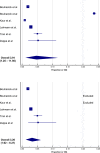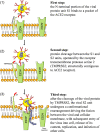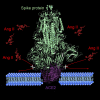The spike effect of acute respiratory syndrome coronavirus 2 and coronavirus disease 2019 vaccines on blood pressure
- PMID: 36528504
- PMCID: PMC9744686
- DOI: 10.1016/j.ejim.2022.12.004
The spike effect of acute respiratory syndrome coronavirus 2 and coronavirus disease 2019 vaccines on blood pressure
Abstract
Among the various comorbidities potentially worsening the clinical outcome in patients hospitalized for the acute respiratory syndrome coronavirus-2 (SARS-CoV-2), hypertension is one of the most prevalent. However, the basic mechanisms underlying the development of severe forms of coronavirus disease 2019 (COVID-19) among hypertensive patients remain undefined and the direct association of hypertension with outcome in COVID-19 is still a field of debate. Experimental and clinical data suggest that SARS-CoV-2 infection promotes a rise in blood pressure (BP) during the acute phase of infection. Acute increase in BP and high in-hospital BP variability may be tied with acute organ damage and a worse outcome in patients hospitalized for COVID-19. In this context, the failure of the counter-regulatory renin-angiotensin-system (RAS) axis is a potentially relevant mechanism involved in the raise in BP. It is well recognized that the efficient binding of the Spike (S) protein to angiotensin converting enzyme 2 (ACE2) receptors mediates the virus entry into cells. Internalization of ACE2, downregulation and malfunction predominantly due to viral occupation, dysregulates the protective RAS axis with increased generation and activity of angiotensin (Ang) II and reduced formation of Ang1,7. Thus, the imbalance between Ang II and Ang1-7 can directly contribute to excessively rise BP in the acute phase of SARS-CoV-2 infection. A similar mechanism has been postulated to explain the raise in BP following COVID-19 vaccination ("Spike Effect" similar to that observed during the infection of SARS-CoV-2). S proteins produced upon vaccination have the native-like mimicry of SARS-CoV-2 S protein's receptor binding functionality and prefusion structure and free-floating S proteins released by the destroyed cells previously targeted by vaccines may interact with ACE2 of other cells, thereby promoting ACE2 internalization and degradation, and loss of ACE2 activities.
Keywords: ACE2; Blood pressure; COVID-19; COVID-19 vaccination; Hypertension; Renin-angiotensin system; SARS-CoV-2; Spike protein; Vaccines.
Copyright © 2022 European Federation of Internal Medicine. Published by Elsevier B.V. All rights reserved.
Figures








Similar articles
-
COVID-19, vaccines and deficiency of ACE2 and other angiotensinases. Closing the loop on the "Spike effect".Eur J Intern Med. 2022 Sep;103:23-28. doi: 10.1016/j.ejim.2022.06.015. Epub 2022 Jun 22. Eur J Intern Med. 2022. PMID: 35753869 Free PMC article. Review.
-
New Viral Diseases and New Possible Remedies by Means of the Pharmacology of the Renin-Angiotensin System.J Renin Angiotensin Aldosterone Syst. 2023 Jul 12;2023:3362391. doi: 10.1155/2023/3362391. eCollection 2023. J Renin Angiotensin Aldosterone Syst. 2023. PMID: 37476705 Free PMC article. Review.
-
Disequilibrium between the classic renin-angiotensin system and its opposing arm in SARS-CoV-2-related lung injury.Am J Physiol Lung Cell Mol Physiol. 2020 Aug 1;319(2):L325-L336. doi: 10.1152/ajplung.00189.2020. Epub 2020 Jul 8. Am J Physiol Lung Cell Mol Physiol. 2020. PMID: 32639866 Free PMC article. Review.
-
Hypothesis for renin-angiotensin inhibitor mitigation of COVID-19.Med Hypotheses. 2021 Jul;152:110609. doi: 10.1016/j.mehy.2021.110609. Epub 2021 May 12. Med Hypotheses. 2021. PMID: 34048987 Free PMC article.
-
Two hits to the renin-angiotensin system may play a key role in severe COVID-19.Kaohsiung J Med Sci. 2020 Jun;36(6):389-392. doi: 10.1002/kjm2.12237. Epub 2020 Jun 3. Kaohsiung J Med Sci. 2020. PMID: 32492292 Free PMC article. Review.
Cited by
-
Novel risk loci for COVID-19 hospitalization among admixed American populations.Elife. 2024 Oct 3;13:RP93666. doi: 10.7554/eLife.93666. Elife. 2024. PMID: 39361370 Free PMC article.
-
Evolution of Cardiovascular Risk Factors in Post-COVID Patients.J Clin Med. 2023 Oct 15;12(20):6538. doi: 10.3390/jcm12206538. J Clin Med. 2023. PMID: 37892676 Free PMC article.
-
Safety pharmacology of human endogenous retrovirus-enveloped baculoviral DNA vaccines against SARS-CoV-2 in Sprague-Dawley rats and beagle dogs.Vaccine X. 2024 Aug 3;20:100545. doi: 10.1016/j.jvacx.2024.100545. eCollection 2024 Oct. Vaccine X. 2024. PMID: 39221182 Free PMC article.
-
Complications of SARS-CoV-2 Infection During Cardiac Rehabilitation: A Case Series.Cardiol Ther. 2023 Sep;12(3):533-538. doi: 10.1007/s40119-023-00325-6. Epub 2023 Jul 15. Cardiol Ther. 2023. PMID: 37453974 Free PMC article.
-
The Global Burden of Resistant Hypertension and Potential Treatment Options.Eur Cardiol. 2024 Jun 19;19:e07. doi: 10.15420/ecr.2023.51. eCollection 2024. Eur Cardiol. 2024. PMID: 38983582 Free PMC article. Review.
References
Publication types
MeSH terms
Substances
LinkOut - more resources
Full Text Sources
Medical
Miscellaneous

